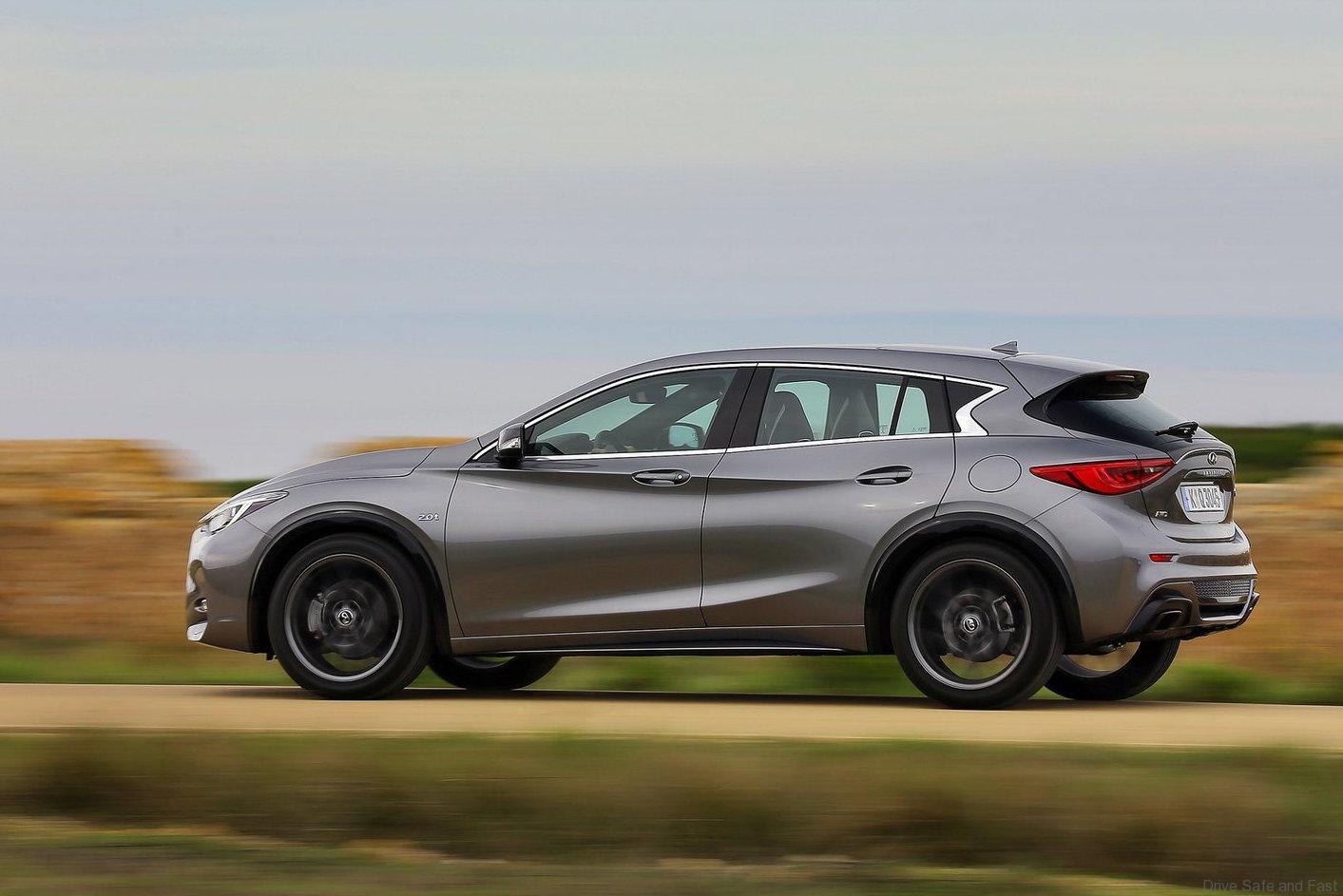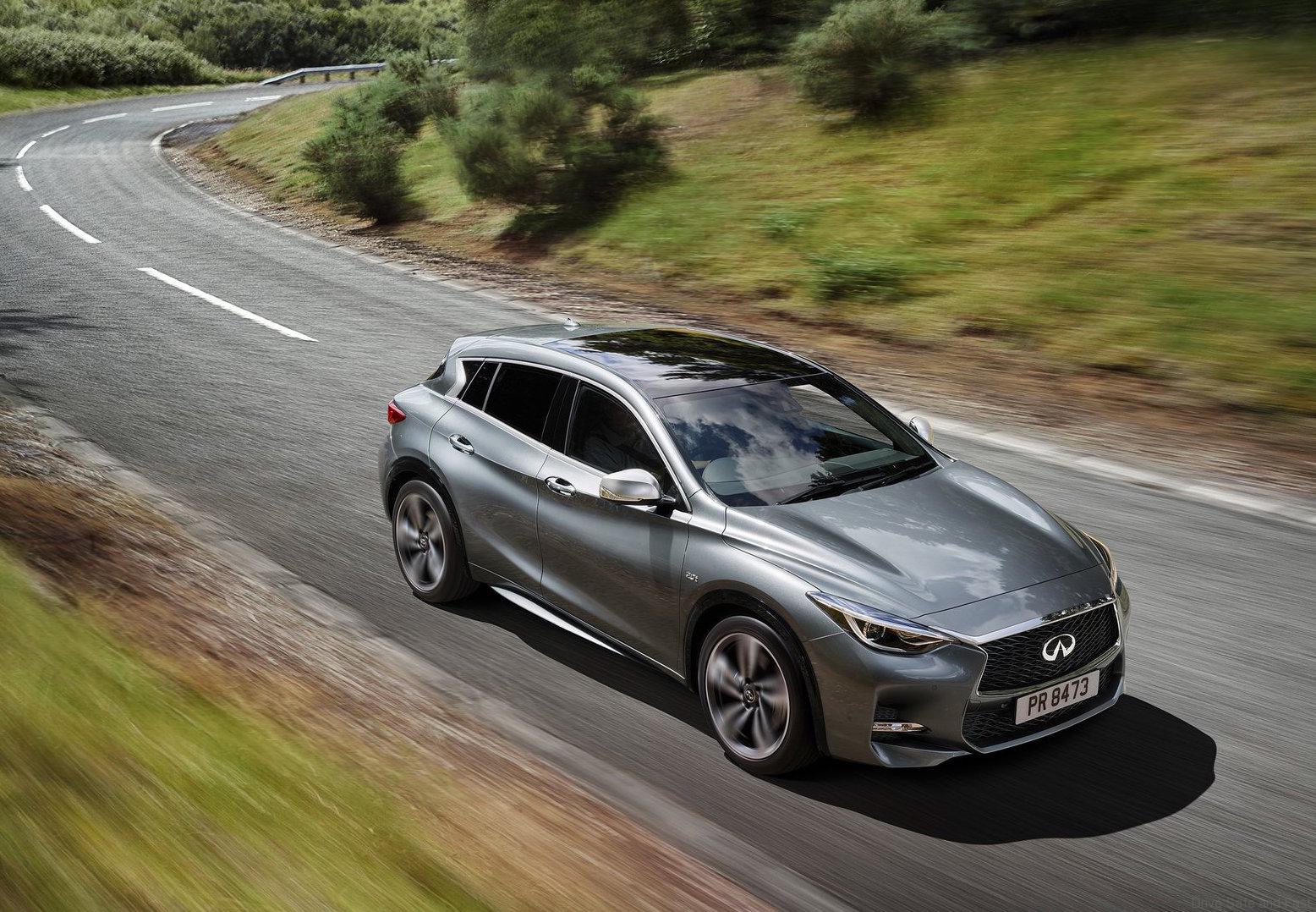The Q30 gives Infiniti the best platform from which to achieve its goals in key markets globally. It will become the company’s first ever vehicle built in Europe, at newly-upgraded production facilities in Sunderland, United Kingdom.
Q30 is the beginning of Infiniti’s push to expand its product line-up
With the launch of the Q30 active compact, Infiniti has started to deliver on the promise to expand and refresh its product portfolio within new premium segments. Representing the first vehicle of its kind for the company, Infiniti has dared to be bold and ambitious with the Q30 active compact. The car defies categorisation with its rare shape and elevated stance. Its expressive design targets premium customers seeking urban individuality.
The alloy wheels allow for true personalisation, with a laser-cutting process enabling the precise application of an accent colour of choice. The process is so precise that the bespoke coloured lines can be as thin as 0.3mm, offering a subtle way of making the car your own.
Complementing the bespoke nature of Q30, perceptual quality levels meet the expectations and high standards of buyers in the premium compact segment. Superior fit and finish details, both visible and tactile, are available across all grades. For example, a satin chrome-plated trim, rather than plastic chrome, gives Q30 a “cool-to-the-touch” feel, even in hot temperatures, while consistent use of black lacquer trim across wheel arches and side sills highlights the Q30’s elevated stance, contributing to the strong, unique road presence of the vehicle.
Q30 takes a design-led approach that forges a unique path
An important, differentiating characteristic of the Q30’s design is its combination of elevated stance with an overall height that is comparable with models in the traditional compact segment (1,495mm for base and Premium, 1,475mm for Sport). The result is a highly distinctive, coupe-like silhouette, which is further emphasised by a shallow side glass area.
The Q30 takes Infiniti’s signature design cues and evolves them into new dynamic shapes. The double-arch grille with 3D mesh, for example, has grown from the Q50, with a more fluid movement into the headlamps. The dramatic curves and turbulent lines flow up the signature double-wave bonnet, over the fenders and across the body line into the strong shoulder of the car. The signature C-pillar arcs forward in a dynamic crescent shape that emphasises motion, even when stationary. The contrast of the long, low-slung roof-line, conjuring an image of a rakish shooting brake in silhouette, and elevated stance add to the visual impact.
Above the SE Q30 model, two grades, ‘Premium’ and ‘Sport’, permit opportunities for further individual expression through exterior design.
The Q30 Premium includes LED front fog lamps, body-coloured and heated doormirrors, as well as chrome dual rectangular exhaust finishers. 18-inch alloy wheels add to the Premium grade’s striking appearance.
The face of the Q30 Sport is slightly different, thanks to a shapely bespoke bumper and gloss black front grille. Custom body-coloured side sills give the car a striking, in-motion look, while a sporty rear bumper is joined by dark chrome dual rectangular exhaust finishers. 19-inch alloy wheels complete the confident look of the Sport model.
The Q30 Premium’s elevated stance allows for a higher hip point (531mm), which aids ingress and egress. The A-pillar design is intentionally slim, contributing to enhanced visibility for a confident driving experience. Q30 Sport stands a little lower, providing for agile ride and handling.
The Q30’s coupe-like design belies its interior space and functionality. Cabin room is highly competitive, notably the boot capacity of 368 litres VDA, which ranks among the best in the premium compact segment.
Infiniti’s bold approach to design continues inside the Q30, where buyers will find an expressive interior that challenges traditional standards of symmetry in automotive design.
The beautifully styled, asymmetric surfaces feature wave shapes and dynamic lines that twist apart and flow away from the driver. This ‘dissymmetry’ alters the conventional perception of occupant areas, creating a more pleasant environment in which to spend time.
Custom-designed trims deliver a personalised, self-expressive interior design. ‘City Black’ blends black upholstery with purple stitching, ideal for the all-night urbanite. ‘Cafe Teak’ combines classy brown and black upholstery with black stitching, providing a modern twist on traditional concepts of premium. ‘Gallery White’ endows Q30 with a fashionable, high-contrast appearance, featuring white leather with red accents. All three ‘designer’ trims accentuate the Q30’s stand-out interior, and will add to the car’s appeal for open-minded premium buyers looking for a new, creative approach to cabin design.
Infiniti interior designers have also selected the highest quality materials and processes available to create a modern-looking and luxurious cabin. For example, a super-soft, highly tactile material lines high-impact areas of the interior, such as door trims and the centre armrest, while ‘Dinamica®’, a new Italian suede-like material used increasingly in the high-fashion industry, has been applied to the roof-line and pillars.
Interior noise levels in Q30 add to the overall cabin comfort. Infiniti sound engineers used the official Articulation Index, a standard way of measuring the level of speech intelligibility provided in a space, to measure the quality of occupant conversation within the cabin. Q30 features a 10% improvement in audibility over the leading segment competition at a speed of 120kph.
Quietness in the cabin is aided by Active Noise Cancellation, which emits sound waves from the four door speakers to negate any instances of booming noise emanating from the 2.2-litre diesel engine. Sound-damping materials further reduce the impact of unwanted noise, either from the engine or exterior elements, while the closed sections of the high-rigidity body structure protect the Q30 from any negative noise and vibration generated by broken or inconsistent road surfaces.
Further interior comfort is guaranteed thanks to an advanced seat design. The seatback has been carefully engineered to match the curvature of the spine, providing consistent spinal support and minimising pressure on back muscles. A wider fitting shape on the seats distributes weight more evenly, while the softness of the seat cushion provides enhanced support and comfort. Internal testing by Infiniti engineers showed that the Q30 seat back section distributes load more effectively than its competitors in the segment.
For drivers wanting to add to the dynamic feel inside the Q30, sports seats with integrated headrests are available for the first time in an Infiniti, featuring eight-way adjustment and power lumbar support. The Q30 Sport features a leather-wrapped, flat-bottomed steering wheel, as well as aluminium pedals, adding to the in-control driving experience.
On certain grades, drivers can also stay in tune with the dynamic performance of the Q30 through Active Sound Enhancement, which monitors acceleration behaviour and gear ratio, smoothing out variations in engine tone to project a harmonious and exhilarating sound when accelerating.
Confident dynamics deliver a holistic driving experience
The priority for Infiniti engineers was to strike an ideal balance between ride and handling. The car stays firm on the road thanks to specially tuned shock absorbers, with engineers testing over 50 variations on prototype vehicles before arriving at the optimal setting, while the driving remains smooth throughout. Body stiffness has been enhanced to the benefit of the driver, eliminating negative sensations and audio cues, so the Q30 experience feels and sounds controlled.
Infiniti engineers have designed the suspension to be both forgiving and comfortable, without sacrificing agility. Bump shock rates and shock absorber rebound rates have been specially tuned, while MacPherson front struts offer tight packaging to best handle Q30’s size and weight. A multilink system at the rear offers precise wheel control in all any conditions.
The Q30’s steering has been tuned to deliver a consistent and connected feeling, thanks to an intuitive speed-sensitive system. A light and nimble feel makes the car easier to control in busy city traffic and urban environments, reducing stress and driver fatigue, while a gradual increase in resistance according to incremental changes in speed boosts driver confidence and control.
Depending on the grade, Q30’s suspension settings endow unique performance attributes. The SE and Premium model are best suited to the varied and often inconsistent road surfaces found in urban environments, the suspension set-up biased towards reducing vibration and harshness picked up from the road.
The Q30 Sport, with 15mm lower ground clearance than the SE and Premium versions, gives a firmer ride, facilitating tighter body control and reduced roll, without compromising comfort. The Sport grade has been engineered to be used comfortably on a daily basis while offering an intuitive, in-control driving experience.
A varied range of powertrain options are available, all tuned to provide exciting power delivery. In the base model, a 1.6-litre engine, with either 90kW (120hp, 122PS) or 115kW (154hp, 156PS) will be joined by diesel options that include 1.5-litre and 2.2-litre engines, both four cylinder, with 80kW (107hp, 109PS) and 125kW (168hp, 170PS) power outputs, respectively.
In addition to these powertrain options, Premium and Sport models add a 2.0-litre, four-cylinder petrol engine producing 155kW (208hp, 211PS).
Automatic gear shifts are smooth and seamless thanks to a seven-speed dual-clutch transmission. The dual clutch intelligently pre-selects gears so the next shift is always ready to go, while manual mode with paddle shifters lets the driver control gear changes when desired. Well-spaced ratios promise comfortable acceleration thanks to an even distribution of power, whether at a steady or fast pace, while quick and supple changes are ensured using either the fully automatic mode or the paddle gear selectors. Torque is almost uninterrupted between changes, reducing lurching while in motion and between shifts.













